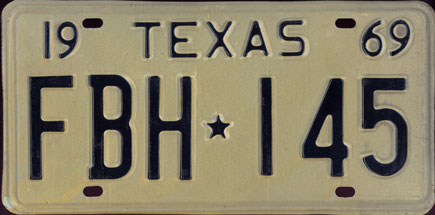 |
Texas 1969 Passenger issue. Texas plates of this era were issued in an ABC-123 format with a "lone star" separator between numbers and letters. Leading zeroes were not used with the numbers, so numbers below 100 would be issued in an ABC-12 format. 1969 was the first year for plate reflectorization in Texas. From 1969 through 1975, plates issued in odd-numbered years were black on white, and even years were various colors. |
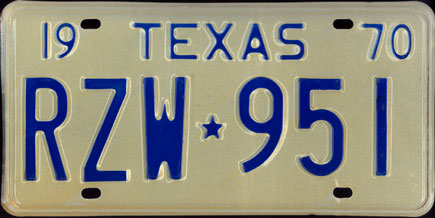 |
Texas 1970 Passenger issue. Same format as above, colors were blue on white for 1970. |
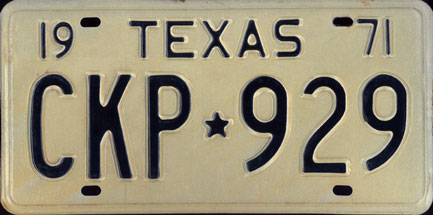 |
Texas 1971 Passenger issue. Another black-on-white plate was issued in 1971, with early plates in the series being identical in format to the 1969 issue. The "19" was dropped from the embossed date in later issues, see next plate. This plate was obtained as a mint leftover plate and still had the paper backing placed in the package between the plates. This backing contains an advertisement for the "Texas Prison Rodeo", featuring "Guest Stars, Thrilling Inmate Contests, Pageantry and Quadrilles." Sounds like a heck of a good time to me, especially the Thrilling Inmate Contests. |
 |
Texas 1971 Passenger issue. After approximately the early "D" series of 1971 passenger plates, the "19" was removed from the top left corner of the plate. I'm not sure why this was done, although a good theory is that it was an attempt to distinguish the 1971 plates from other black-on-white odd-year plates. |
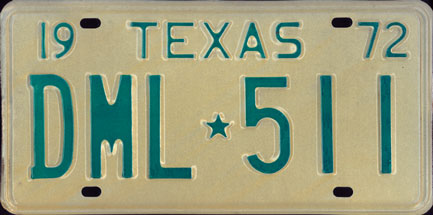 |
Texas 1972 Passenger issue. Back to the standard format with the "19" in the year again, green on white this time around. |
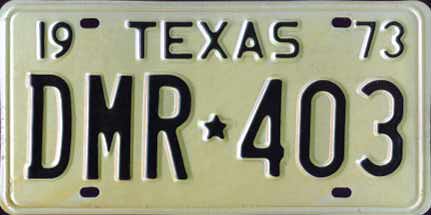 |
Texas 1973 Passenger issue. Another black-on-white issue for 1973. |
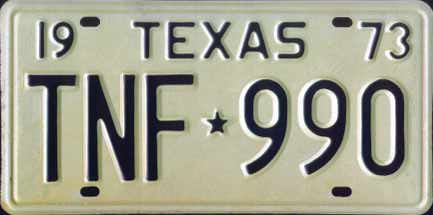 |
Texas 1973 Passenger issue. Late issues in 1973 were produced with an different die set, which was also used for most of the 1974 issue. This was likely due to late 1973 plates being produced after the 1974 production run had begun. |
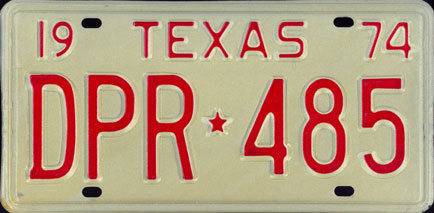 |
Texas 1974 Passenger issue. This was the last yearly plate issue for Texas, and the only to use these distinctive dies (aside from the late-issue 1973 plates as above). Colors were red on white for 1974. |
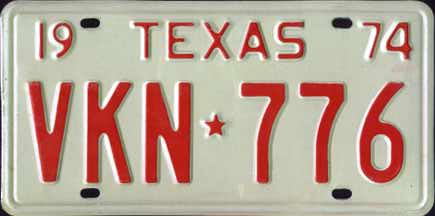 |
Texas 1974 Passenger issue. Late period 1974 plates switched to a new die set, which is still used today. Characters were slightly wider and shorter, with the letters and numbers brought to the same height. Only a small number of these 1974 plates in the "Vxx" series used these dies. Presumably, these were produced late in the year, after production of the 1975 plate was already underway. |
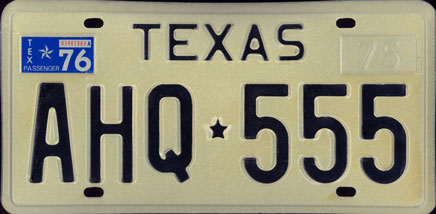 |
Texas 1976 Passenger issue (1975 base). At the end of 1974, these new plates were issued, with a debossed "75" in the upper right sticker box. In keeping with odd-year tradition, they were black on white, but were intended for multi-year use. Early plates in this series, approximately the first half of the alphabet, retained the star divider from previous issues. Later plates switched to a new divider in the shape of Texas (still used today in screened form) and also a more silver-white color for the background. These 1975 baseplates were used with stickers through the end of 1991. |
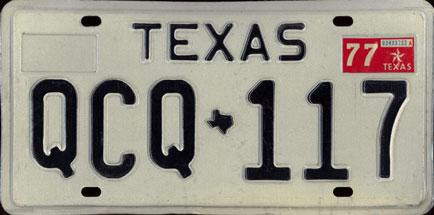 |
Texas 1977 Passenger issue. This is a later-period 1975 issue, with the state-shaped divider and more silver-toned background. These plates were used with single year stickers through the end of 1977, and in 1978 staggered registration and month stickers were introduced. Two "Q"s on one plate, too, such a find! |
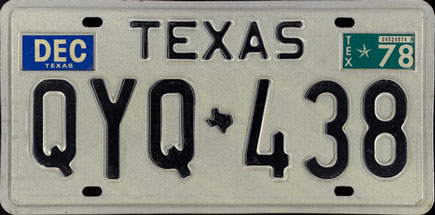 |
Texas 1978 Passenger issue. Starting in 1977 in the QQY series, the debossed '75' was removed from the top right sticker well of these plates. Staggered registration was established in 1978, adding month stickers to the top left of the plate. This was one of the earliest natural staggered registration plates, issued in January, 1978 with a twelfth-inclusive month (DEC 78) expiration. |
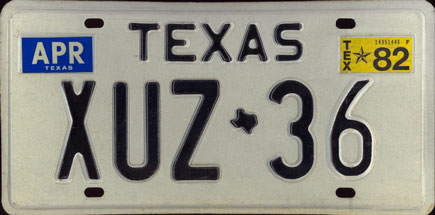 |
Texas 1982 Passenger issue. Again on this baseplate, serials less than 100 for each letter combination were issued in an ABC-12 format. These plates can be mistaken for vanity plates due to the odd format, however vanities were re-issued yearly in Texas during this period and used a different color scheme than the regular passenger issues. This format was discontinued when the numbering format was switched to 123-ABC, as the state started placing leading zeroes in front of serials under 100. |
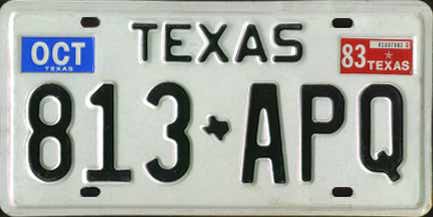 |
Texas 1983 Passenger issue. When the ABC-123 format was exhausted around 1982, plates were switched to a reversed 123-ABC format. These plates no longer carried the debossed "75" in the top right sticker box. Plates of this type were issued through the early "H" series in 1985. |
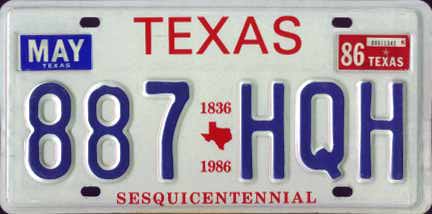 |
Texas 1986 Passenger issue. 1n 1985, Texas began issuing this new baseplate, commemorating the Sesquicentennial of Texas' independence from Mexican control. This change occurred in the early the "H" series of plates (somewhere between the HDx and HFx series) and these issues were used concurrently with the 1975 baseplates. This plate was issued through 1986 and could be used with stickers through 1995. |
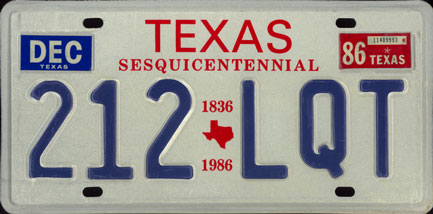 |
Texas 1986 Passenger issue. In late 1985, the Sesquicentennial base was changed slightly, moving the "Sesquicentennial" up under the state name rather than at the bottom of the plate. The change was made because the slogan was too easily obscured by plate frames, etc. at the lower location. Either that, or the state just wanted to frustrate completist collectors by adding another variation to the list. These plates were issued through the end of 1986 and could be revalidated through 1995 as well. |
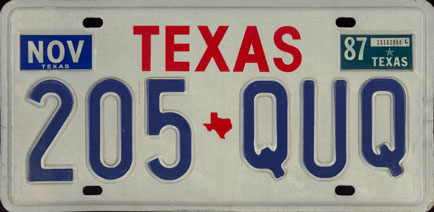 |
Texas 1987 Passenger issue. In late 1986, the Sesquicentennial base gave way to this baseplate. It retained the colors of the previous base, but featured a bolder screened state name, giving this plate the nickname "Big Red". This plate was issued from approximately the start of the "Q" series through plate number 999-ZZZ. A few plates were issued in an ABC-12D format on this base, but these are rare (see next plate). These plates were issued through early 1990 depending on the county and then phased out by 1997 as part of Texas' seven-year rolling replacement cycle. |
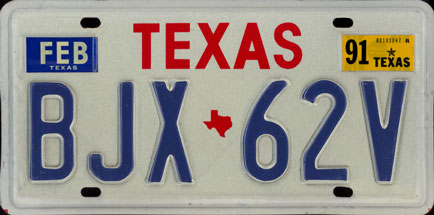 |
Texas 1991 Passenger issue. This is a continuation of the Big Red baseplate, with a modified numbering format. When plate number 999-ZZZ was reached, the sequence was changed to ABC-12D, which was used until exhaustion in early 1998. This sequence started at BBB-01B, since Texas does not use vowels on newer plates. This format on this baseplate is somewhat rare, as the baseplate was changed to the next variation at the "BKX" series. These plates were issued through early 1990. |
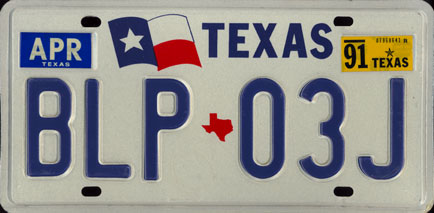 |
Texas 1991 Passenger issue. In late 1989, this new baseplate featuring the state flag was introduced. It was issued in a continuation of the ABC-12D format, starting at the "BKX" series. Again, no vowels or "Q"s were used on this base. This variation was issued through approximately 1992, when a new slogan was added to the plate. Plate stickers were used on this plate through 1994, when replaced by windshield stickers, so an inordinate number of these issues are found with the "94" stickers, as this was the last year that plate stickers were used. These plates were phased out by the end of 1999 through the replate process. |
 |
Texas 1993 Passenger issue. This plate was a continuation of the above "Flag" base, with the slogan "The Lone Star State" added at the bottom. This variation was used from the "GTY" series of these plates through nearly the end of the series at ZZZ-99Z, with a break in between for a special plate issue in 1995-96. |
 |
Texas undated Passenger issue (circa 1995). Plates issued to expire in January, 1995 and beyond used windshield validation stickers rather than plate stickers, so plates of this era did not carry stickers at all. |
 |
Texas undated Passenger issue (circa 1996). This special issue became the standard Texas baseplate in 1995-96, briefly interrupting the Lone Star baseplate. This series started in the "VJL" series and ran through the late "W" plates. These plates were used exclusively with windshield stickers, so no plate stickers are used. This plate brings up an odd situation, as Texas had already introduced a Sesquicentennial issue 10 years previous. This plate actually marks the 150th anniversary of Texas statehood in 1845, while the 1986 plate celebrates the independence of Texas from Mexican control in 1836. Texas was an independent republic from 1836 to 1845. This plate won ALPCA's Plate of the Year award in 1995. |
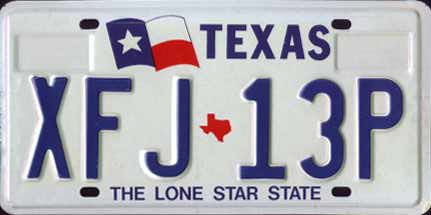 |
Texas undated Passenger issue (circa 1997). After the 150 Years base was discontinued in 1996, the state returned to the standard Lone Star base. This format held until the late "Z" series of plates (see next). |
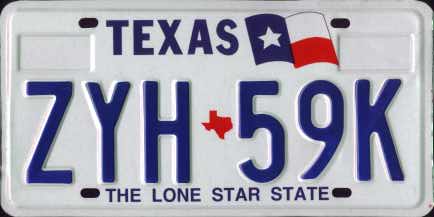 |
Texas undated Passenger issue (circa 1997). Some later-period Lone Star plates in the ABC-12D format were stamped on a new base with the state flag moved to the right of the state name. This is thought to be a manufacturing error, as these bases were intended for use with the next numbering format. These plates all occurred in the late "Z" series, such as this one. |
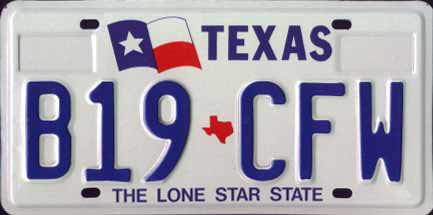 |
Texas undated Passenger issue (circa 1998). When the ABC-12D series plates were exhausted at ZZZ-99Z, the state changed to a "reverse" series A12-BCD format. Some early issues of this new A12-BCD format plate were stamped on older left-flag bases. I suspect that the number of these is equal to the number of "Z" plates stamped on right-flag bases, as they were probably just mixed up. |
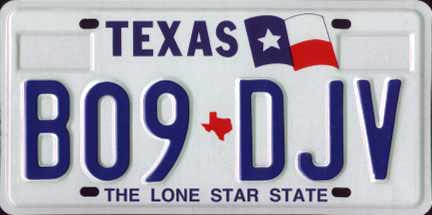 |
Texas undated Passenger issue (circa 1998). This is the correct format for this issue of Texas plates, with the reversed A12-BCD format and the flag on the right of the state name. |
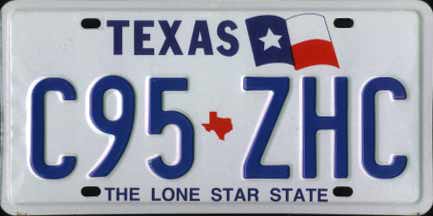 |
Texas undated Passenger issue (circa 1998). Continuation of the above baseplate, at some point in the early C12-xxx series, the state finally removed the sticker boxes from the top of the plates. Since windshield stickers were implemented after 1994, these boxes were obviously not necessary. This re-tool may have also been caused by the state gearing up to produce its subsequent graphic plates, as seen below. The flag plate series was discontinued after plate number J99-GPZ. |
 |
Texas undated Passenger issue (circa 1999). This graphic baseplate was introduced in 1999 starting at plate number J01-GRB. The plates feature a graphic of a cowboy riding the range with oil fields in the background at the bottom, and a space shuttle, stars and moon in the sky above. The state-shaped separator remains, as does the slogan "The Lone Star State". |
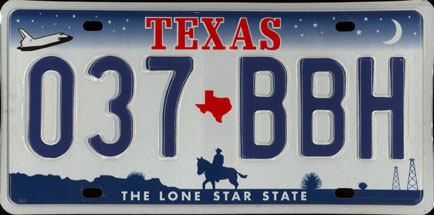 |
Texas undated Passenger issue (circa 2004). In late 2004, Texas reached plate number Z99-ZZZ, exhausting the A12-BCD format that was started back in late 1997-early 1998. The state then reverted to a 123-ABC format, starting with 001-BBB (again, all vowels skipped in the series). The last time this format was used was for plates issued between 1982 and 1990, all of which were long replaced by the time these came out. Initial plates in this series were made of steel, with a change to aluminum occurring around the Fxx series. |
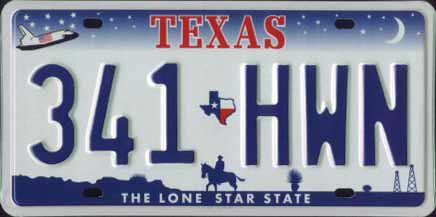 |
Texas undated Passenger issue (circa 2005). In 2005, the state tweaked the graphic elements of the plate slightly, resulting in this revised version. Changes from the previous graphic include an American flag added to the space shuttle, a slightly smaller cowboy and horse, the addition of the state flag motif within the state-shaped divider at the center, and seven pronouncedly larger stars above the shuttle in the top left. This last design element was to honor the seven astronauts lost in the Space Shuttle Columbia disaster in 2003. |
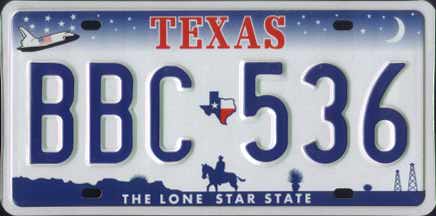 |
Texas undated Passenger issue (circa 2007). It only took three years for Texas to run through the entire 123-ABC format series on this base and once again require a new serial format. In late 2007, the state flipped to the ABC-123 series (again skipping vowels for a starting point of BBB) which was last seen on the 1975 base and issued through 1982. These plates are identical to the last base aside from the numbering format. |
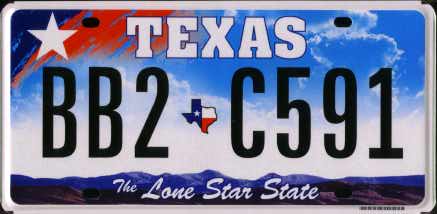 |
Texas undated Passenger issue (circa 2009). Texas released this graphic issue in mid-2009. This design, featuring clouds in the sky above a mountain range in the distance along with red and blue streaks at the top, was chosen among several finalists in online voting in 2008. This is the first Texas passenger issue to be produced as a flat plate, unfortunately using 3M's most common generic serial font. A seven-digit serial was also introduced for the first time to avoid exhausting available numbers so quickly. For reasons unknown, the state chose this mixed-case AB1-C234 serial format, with passenger issues continuing to skip vowels resulting in the sequence beginning at BB1-B001. |
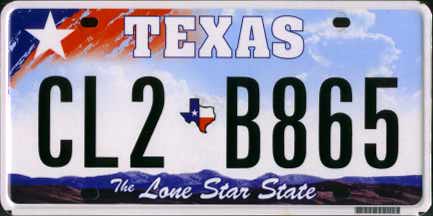 |
Texas undated Passenger issue (circa 2011). The 2009 Texas issue was modified in early 2011 amid complaints from law enforcement regarding the legibility of the plates. Specifically, the dark blue sky made it difficult to read the serial of the plates properly. In response, the plate was redesigned to significantly lighten up the sky's coloring to a much paler blue, with the serial also dropping slightly to minimize the overlap with the blue background. This change was reportedly made somewhere in the CJ- series. |
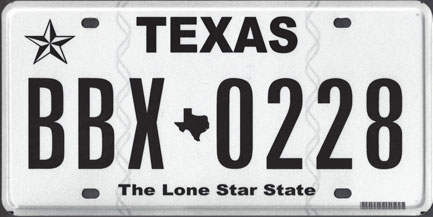 |
Texas undated Passenger issue (circa 2012). Starting in August, 2012, Texas discontinued the 2009 graphic base due to continued legibility complaints. The replacement issue is a stark black on white plate, abandoning all graphic elements and switching to a more straightforward ABC-1234 serial format (a change which, in itself, probably would've sufficed in addressing 95% of the legibility issues on the graphic base.) This plate is being spun as the "Texas Classic" plate due to the use of the 60's-70's era black and white motif, despite the seven-digit flat issue bearing no real resemblance to any of the classic Texas issues. |


































